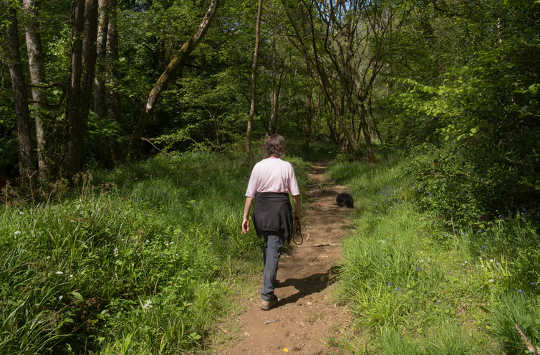 Peter Turner Photography / shutterstock
Peter Turner Photography / shutterstock
Has your doctor recommended you go for regular jogs in the park, countryside walks, community food growing sessions, or some other nature-based activity? These so-called “green prescriptions” are typically given alongside conventional therapies and have existed in various forms for a number of years.
In recognition of the potential health benefits of green prescriptions, the UK government has just announced a £4 million investment in a two-year pilot as part of its post-COVID-19 recovery plan, with plans to scale up in the future.
There is increasing evidence of the benefits of contact with nature, and the World Health Organization has identified ten ways in which nature impacts positively on our physical and mental health. When parks and other greenspaces are accessible and inclusive they can promote physical activity, psychological relaxation and social cohesion.
There is even evidence to suggest that contact with microbes in the environment can “train” our immune systems and reinforce the microbial communities on our skin, and in our airways and guts. These “microbiomes” could play a role in how our bodies respond to infectious diseases such as COVID-19 and to secondary infections. Microbes from the environment could also potentially supplement our bodies with fatty acids such as butyrate, which are linked to reduced inflammation and may promote mental health.
Green prescriptions therefore have huge potential. But if they are to work, they need to be seen as the start of a much more holistic mode of health and social care delivery: part of a post-COVID “new normal”. This would chime strongly both with the renewed appreciation of nature and the surge in community mobilisation and action we saw under the lockdown.
This needs to go beyond simply substituting green for conventional prescriptions. Instead we should provide greener, more natural settings and practices for health, social care, education, transport and active travel. A good example is the GoGoGreen project at a primary school we have worked with in Sheffield. There, greening a school playground not only created a barrier against air pollution from vehicle emissions but also provided multiple other benefits to the school community and started a conversation about cleaner modes of travel.
Green prescribing cannot be seen as a low-cost alternative to conventional treatments. To be effective it still demands investment and resources. The two year pilot is welcome, but if it is to be successful in the long-run the government must make a firm commitment to scaling-up while also addressing systemic issues such as social inequality. All this will take time, and if this holistic approach is not adopted then people in crisis with more immediate priorities will be less likely to go on that prescribed walk in the woods.
Our own research on improving wellbeing through urban nature in Sheffield confirms that people in more deprived communities, with poorer health and shorter life expectancies, don’t have the same levels of access to high quality, well-maintained greenspaces. These are the people that arguably most need green prescriptions, but if they don’t have the basic access then those prescriptions are unlikely to be effective. What’s more, many doctors are not aware of green prescribing, nor do they have a firm understanding of the benefits or know how to get involved.
Our research also reveals that context is critical and green prescriptions need to be rooted in their local area and closely related to the people and places who are going to use them. A wealthy white pensioner in a rural area is likely to have very different experience of and access to nature compared with a young working class person of colour in an inner city. A formulaic top-down approach is unlikely to work for both these people.
Recommendations
To sum up, this is what we need to make green prescriptions a success.
They have to be part of a systemic approach to incorporating nature-based interventions and nature-based thinking in urban infrastructure and service provision.
The prescribing process needs to be made easy, for doctors, social care professionals and patients. GPs often lack time and resources, while patients may lack motivation and confidence, or have little previous positive experiences of nature.
Green prescribing also needs to be seen as one part of a holistic health-promotion strategy based on a planetary health perspective. In order to care for ourselves, we also need to care for our environments.
Finally, we need new ways of working with local organisations and communities to understand what’s needed in local contexts, and to build skills and capacity.
About The Author
Anna Jorgensen, Chair in Urban Natural Environments, Health and Wellbeing, University of Sheffield and Jake M. Robinson, PhD Researcher, Department of Landscape, University of Sheffield
This article is republished from The Conversation under a Creative Commons license. Read the original article.
Books on Fitness and Exercise from Amazon's Best Sellers list
The Four-Pack Revolution: How You Can Aim Lower, Cheat on Your Diet, and Still Lose Weight and Keep It Off
by Chael Sonnen and Ryan Parsons
The Four-Pack Revolution presents a total-life approach for attaining health and fitness goals without the hard work and suffering.
Click for more info or to order
Bigger Leaner Stronger: The Simple Science of Building the Ultimate Male Body
by Michael Matthews
If you want to build muscle, lose fat, and look great as quickly as possible without steroids, good genetics, or wasting ridiculous amounts of time in the gym and money on supplements, then you want to read this book.
Click for more info or to order
The Women's Health Big Book of Exercises: Four Weeks to a Leaner, Sexier, Healthier You!
by Adam Campbell
The Women's Health Big Book of Exercises is the essential workout guide for anyone who wants a better body. As the most comprehensive collection of exercises ever created, this book is a body-shaping power tool for both beginners and longtime fitness buffs alike.
Click for more info or to order
Bodyweight Strength Training Anatomy
by Bret Contreras
In Bodyweight Strength Training Anatomy, author and renowned trainer Bret Contreras has created the authoritative resource for increasing total-body strength without the need for free weights, fitness machines, or even a gym.
Click for more info or to order
The Men's Health Big Book of Exercises: Four Weeks to a Leaner, Stronger, More Muscular You!
by Adam Campbell
The Men's Health Big Book of Exercises is the essential workout guide for anyone who wants a better body. As the most comprehensive collection of exercises ever created, this book is a body-shaping power tool for both beginners and longtime fitness buffs alike.
























